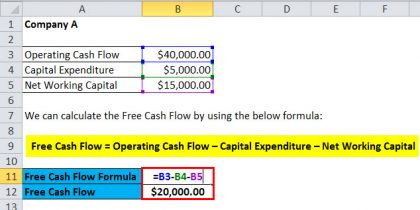

The indirect method can be calculated by using the following formula: Indirect Method to Calculate OCFĪs stated above, the indirect method provides a better insight into business operations because it accounts for non-cash items, depreciation, and any other adjustments. One is the direct method, which gives an overview of your business’s profitability, and the other is the indirect method, which gives you a broader perspective on your business operations. There are two methods used to calculate operating cash flow. Methods to Calculate OCF (Operating Cash Flow) Net income is defined as the total revenue that a company produces from sales after deducting interests, taxes, investments, and all other expenses from the profit. Investments, taxes, and interest rates are not accounted for in the operating cash flow. Operating cash flow can be defined as the profit generated solely from business operations. Operating cash flow and net income are entirely different terms.

Is There a Difference Between OCF and Net Income? banks to determine the creditworthiness of companies to lend them loans.investors observe the profits a company generates in order to invest in the company’s stock.financial analysts observe the operating profit of businesses when they are trying to analyze how successful a business is.That is why it’s advisable to keep track of this metric to be aware of your company’s profitability and where it is headed. Why Do You Need to Calculate OCF (Operating Cash Flow)Ĭalculating operating cash flows is crucial because it represents the company’s financial position. It is the amount of money a company makes after subtracting its operating costs, such as rent, CGS, etc., from its total revenue. Operating cash flow is the profit made by a company following its daily expenses. In addition to many other important financial metrics, operating cash flow stands at the core of the business. CPA Services for Crypto Businesses and Individualsĭespite the fact that 70% of small firms are focused on enhancing their financial stability, almost 30% of them still experience negative cash flows as a result of poor money management. It is crucial to understand the basics of accounting so that you can manage your business finances smoothly.E-Commerce CPA Services for Canadian Shops Selling in the US.US Tax for Canadian Corporations in the US.Tax Preparation Services and Advisement.Consulting, Business Advising, and Valuations.
Calculating operating cash flow software#
Calculating operating cash flow how to#
How to Calculate Operating Cash Flow Ratio (Step-by-Step) The Operating Cash Flow Ratio (OCF) compares the cash flows generated by a company’s core operations to its current liabilities.


 0 kommentar(er)
0 kommentar(er)
